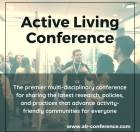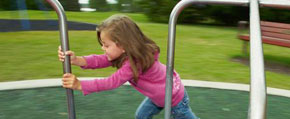We are pleased to announce an exciting new alliance between Active Living Research and GP RED to co-host and coordinate...
Building Design and Site Attribute Predictors of Physical Activity
Presentation at the 2004 Active Living Research Annual Conference
Americans spend much of their days in buildings, yet relatively little is known about how the design of buildings or their sites influences physical activity. Some evidence suggests that use of specific features of buildings such as stairs can have a meaningful impact on health (Boreham, Nevill, Wallace, & Brennan, 1998). The Harvard Alumni Health study of more than 11,000 men found that those who climbed at least 20 floors per week had a 20 percent lower risk of stroke and of death from all causes (Lee & Paffenbarger, 1998). Motivational point-ofdecision prompts can increase stair use, although these effects are dependent on demographic and contextual factors (Blamey, Mutrie, & Aitchison, 1995; Coleman & J. Gonzalez, 2001; Kahn et al., 2002; Kerr, Eves, & Carroll, 2001; Russell & Hutchinson, 2000). A recent study at the Centers for Disease Control and Prevention found that stair use can be increased by relatively small aesthetic interventions such as adding improved lighting, music, carpeting and artwork (Kerr, In press).
However, despite these encouraging findings, the impact of other aspects of how buildings and their sites are designed are less well understood. This paper reviews the available evidence linking design and siting decisions to physical activity and to suggest a framework for promoting research and policy and design interventions.
The paper is organized in three sections. Section One provides a brief description of the kinds of physical activities associated with buildings and sites and proposes a working model. Section Two explores the research evidence suggesting that the form of buildings and sites affect physical activity at several spatial scales: the design of building elements such as stairs or exercise rooms; layout of those elements in a building; overall building design; and the design of sites. Section Three provides a brief overview of how buildings are delivered, focusing on public buildings, and briefly reviews the roles of influences such as codes, guidelines, large clients and media in influencing building design and identifies several “high leverage” opportunities. Section Four proposes a preliminary action plan and logic model outlining several possible research studies and policy interventions.
- DOWNLOAD "zimring_presentation_0.pdf" PDF (0.99 MB) Presentations
STAY UP TO DATE
RECENTLY ADDED TOOLS & RESOURCES
MOVE! A BLOG ABOUT ACTIVE LIVING
The "Active Living Conference" aims to break down research and practice silos and...







